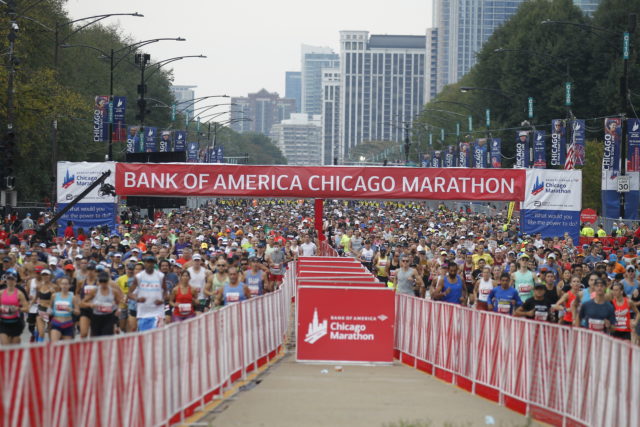By Leah Etling
Known throughout the events industry for dedication to operational excellence and preparedness, the 2021 Bank of America Chicago Marathon excelled on both fronts on Oct. 10, when it returned with the largest U.S. marathon field since the start of the pandemic.*
Just over 26,000 runners participated in the event, under the 35,000 capacity cap announced by the race in June. The pre-pandemic Chicago field cap was set at 45,000 participants.
To ensure the safety of all participants and anyone involved with the race, participants were asked to submit proof of vaccination or a negative COVID-19 test result to access marathon events and run on race day. Early communication to registrants set clear expectations. Ultimately, runners were so eager to get back to the start line that many showed up with both a vaccine card and a negative test result.
“We saw a lot of people coming in with their proof of vaccination AND a negative test. There was not a lot of push back (on those requirements) from our participants. Instead, we got thank yous,” said Carey Pinkowski, CEO and President of Chicago Event Management (CEM), which produces the marathon.
But even with planning and approvals in place, the late-September postponement of the Tokyo Marathon, a fellow World Marathon Major, and 2021 Marine Corps Marathon meant that all eyes were on Chicago to see if the race would go forward.
“When we went out and painted the blue line about five days earlier than we usually paint it, that was all people needed to see. People said well, they wouldn’t have painted the line if they weren’t going to have this race,” Pinkowski said. The blue dashed line runs the duration of the marathon course and marks the most direct route to the finish.
Dr. George Chiampas, Medical Director for the marathon, said he believes that the enthusiastic reaction of runners to vaccination and testing requirements is a positive sign for events of all sizes.
“Runners gravitate to those events that put their best interests and safety at the core of the event, and they want to be a part of those events,” Dr. Chiampas said. Chicago’s comprehensive verification system included dogs trained to detect the presence of the coronavirus in human sweat and identify candidates for additional screening were used on site as an added safety measure.
The effort and preparation required to ensure COVID safety did not distract the CEM team from its continual mission of thorough preparation for potential contingencies.
“One of the great things that Mike (Nishi, COO of CEM and operations lead for the marathon) did was say, we’re focusing on COVID, but let’s not lose sight of other things. Our security, emergency action and evacuation plans were all still at the forefront as we planned,” Pinkowski said. Proof of that was reinforced by an incident free day. Aside from less than ideal warm and humid weather, runners were happy.
“I think we underestimated how excited we were going to be to be out there racing a race of this magnitude again,” said Mike Ko, a non-elite Chicago runner and vlogger who ran 3:14. In a post-race video, he notes that the 3:10 pace group is running with exuberance during the first 10K of the race as he attempts to keep up.
With the reduced field size, Dr. Chiampas and his medical team were ably staffed to handle participants suffering from on-course medical issues. But one factor that he urges races to consider as the pandemic wanes is bandwidth and burnout in the medical community.
“With COVID, you have to really understand what your health care volunteers are going through in the medical space. There’s a massive component of fatigue across all disciplines, and now you’re asking them to come out on their day off and provide their services,” Dr. Chiampas said. “Your private ambulances, city employees, police and fire personnel – they’re all being stretched. You really need to engage with those entities to make sure appropriate safety and security is in place.”
The better news, as Dr. Chiampas sees it, is that the successful return of Chicago and fellow World Marathon Major events Berlin, London and Boston is excellent proof of the industry’s return to normalcy. “Running is back, and these major events have taken place safely. I feel really excited about the future of running,” Dr. Chiampas said.
Pinkowski reflected on the dark days of winter 2020, before the availability of vaccines gave a glimmer of hope that races could resume.
“It was a terrible time of indecision and not knowing the unknown, which is the most intimidating thing you can experience. But we stuck together. People in the industry collaborated, and talked, and picked each other up. We all had a goal of getting there in a safe and secure way. And we got it done.”
*The New York City marathon surpassed Chicago to become the largest race held in the U.S. this year on Saturday, Nov. 7.

